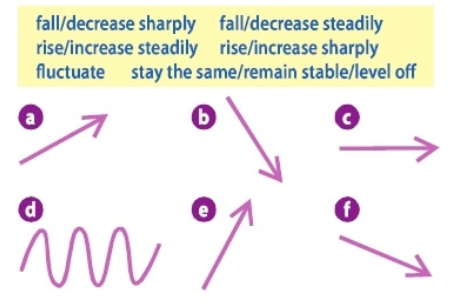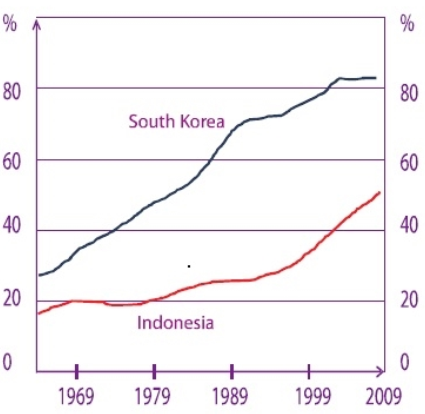Unit 2 lớp 12: Writing trang 26
Hướng dẫn soạn, giải bài tập Tiếng Anh lớp 12 Unit 2: Writing trang 26 chi tiết đầy đủ các phần giúp học sinh làm bài tập Tiếng Anh 12 thí điểm dễ dàng hơn.
Tiếng Anh 12 Unit 2: Writing trang 26
Video giải Tiếng Anh 12 Unit 2: Urbanisation: Writing
Trends in urbanisation (Xu hướng đô thị hóa)
1. (Trang 26 - Tiếng anh 12): Match the phrases in the box with the graphs (a-f).
(Khớp cụm từ trong hộp với đồ thị (a-f).)

Đáp án:
a. rise/increase steadily: tăng dần
b. fall/decrease sharply: giảm mạnh
c. stay the same/remain stable/level off: giữ nguyên
d. fluctuate: biến động
e. rise/increase sharply: tăng mạnh
f. fall/decrease steadily: giảm dần
2. (Trang 26 - Tiếng anh 12): Rewrite the sentences without changing their meaning.
(Viết lại câu mà không làm thay đổi nghĩa của chúng.)
Examples: (Ví dụ:)
* The number of young people working on farms has decreased sharply over the past years.
(Số người trẻ làm việc ở trang trại đã giảm mạnh trong những năm qua.)
=> There has been a sharp decrease in the number of young people working on farms.
(Đã sự giảm mạnh về số lượng người trẻ làm việc ở trang trại trong những năm qua.)
* The number of urban inhabitants rose by 15% from 1990 to 1995.
(Số người sống ở đô thị đã tăng 15% từ năm 1990 đến 1995.)
=> There was a rise of 15% in the number of urban inhabitants from 1990 to 1995.
(Có sự tăng 15% về số người sống ở đô thị từ năm 1990 đến 1995.)
1. The migration of young people to big cities has risen dramatically.
(Lượng dân cư trẻ di cư ra các thành phố lớn tăng đáng kể.)
→ There __________________.
2. Due to shortages of jobs, there has been a decrease in the population in rural areas in the last 10 years.
(Do thiếu hụt việc làm nên có sự sụt giảm dân cư sống ở nông thôn trong 10 năm qua.)
→ Due to shortages of jobs, the population __________________.
3. The urbanisation rate in Indonesia increased by over 30% from 1969 to 2009.
(Tỉ lệ đô thị hóa ở Indonesia tăng hơn 30% từ năm 1969 đến năm 2009.)
→ There __________________.
4. There was a sharp rise in the rate of urbanisation in South Korea during the period between 1969 and 1989.
(Có sự gia tăng mạnh tỉ lệ đô thị hóa ở Hàn Quốc trong thời kì từ 1969 tới 1989.)
→ The rate of urbanisation __________________.
5. The urbanisation rate in this city decreased slightly during the economic crisis in 2008.
(Tỉ lệ đô thị hóa ở thành phố này sụt giảm nhẹ trong khủng hoảng kinh tế năm 2008.)
→ There was __________________.
Đáp án:
1. There has been a dramatic rise in the migration of young people to big cities.
(Đã có sự tăng mạnh mẽ trong việc di chuyển của người trẻ đến các thành phố lớn.)
2. Due to shortages of jobs, the population in rural areas has decreased in the last 10 years.
(Do thiếu việc làm, dân số ở nông thôn đã giảm trong 10 năm qua.)
3. There was an increase of over 30% in the urbanisation rate in Indonesia from 1969 to 2009.
(Từ năm 1969 đến năm 2009, đã tăng hơn 30% trong tỷ lệ đô thị hóa ở Indonesia.)
4. The rate of urbanisation in South Korea rose sharply during the period between 1969 and 1989.
(Tỉ lệ đô thị hóa ở Hàn Quốc tăng mạnh trong khoảng thời gian từ 1969 đến 1989.)
5. There was a slight decrease in the urbanisation rate in this city during the economic crisis in 2008.
(Trong giai đoạn khủng hoảng kinh tế năm 2008, tỷ lệ đô thị hóa ở thành phố này đã giảm nhẹ.)
3. (Trang 26 - Tiếng anh 12): The line graph below shows the urbanisation rate in South Korea and Indonesia. Write a description (of about 150 words) of the trends in the graph.
(Đường đồ thị dưới đây cho thấy tỷ lệ đô thị hóa ở Hàn Quốc và Indonesia. Viết mô tả (khoảng 150 từ) về các xu hướng của đồ thị.)

Gợi ý:
The line graph shows the rate of urbanisation in two countries, namely Indonesia and South Korea, from the mid-1960s to 2009.
In the mid-1960s, the rate of urbanisation in Indonesia was about 17%, followed by a slight increase of 3% in 1969. Then the rate remained stable at around 20% for a ten-year period from 1969 to 1979. In the next fifteen years, there was a steady rise in the rate of urbanisation in this country. From 1995 to 2009, Indonesia's urbanisation rate increased sharply, reaching over 50%.
South Korea's urbanisation rate was about 30% in 1969, roughly 10% higher than that of Indonesia. The rate went up sharply throughout the next thirty-year period to about 82% in 2005 and then leveled off towards 2009.
In conclusion, it is clear that while both countries experienced a growth in their urbanisation rate, in South Korea it almost doubled by the end of the period.
Hướng dẫn dịch:
Đường đồ thị cho thấy tỷ lệ đô thị hóa của hai nước, cụ thể là Indonesia và Hàn Quốc, từ giữa những năm 1960 đến 2009.
Vào giữa những năm 1960, tỷ lệ đô thị hóa ở Indonesia là khoảng 17%, tiếp theo là tăng nhẹ 3% vào năm 1969. Sau đó, tỷ lệ vẫn ổn định ở mức khoảng 20% trong thời gian mười năm từ năm 1969 đến năm 1979. Trong mười lăm năm sau, đã có một sự gia tăng ổn định trong tỷ lệ đô thị hóa ở đất nước này. Từ năm 1995 đến năm 2009, tỷ lệ đô thị hóa của Indonesia tăng mạnh, đạt trên 50%.
Tỷ lệ đô thị hóa của Hàn Quốc là khoảng 30% trong năm 1969, cao hơn so với Indonesia khoảng 10%. Tỷ lệ tăng mạnh trong suốt thời gian ba mươi năm tới khoảng 82% vào năm 2005, và sau đó chững lại khi hướng tới năm 2009.
Kết luận, rõ ràng rằng trong khi cả 2 nước trải qua một sự tăng trưởng đô thị hóa ở tốc độ nhất định, ở Hàn Quốc gần như tăng gấp đôi vào cuối thời kỳ
Xem thêm các bài giải bài tập Tiếng Anh lớp 12 chi tiết, hay khác:
Unit 2: Getting started trang (18,19): Lan and Nam are discussing the plan for their presentation on urbanisation...
Unit 2: Language trang (20,21,22): Look at the conversation in GETTING STARTED again...
Unit 2: Reading (trang 23,24): You are going to read a text about urbanisation...
Unit 2: Speaking (trang 24): Read a conversation betweentwo friends about life in big cities...
Unit 2: Listening (trang 25): Look at the following statistics about urbanisation...
Unit 2: Communication and Culture (trang 27): Listen to a talk about predictions for life in cities...
Unit 2: Looking Back (trang 28): Listen to the words containing diphthongs...
Unit 2: Project (trang 29): Work in groups. Choose a city or a country...
Xem thêm các chương trình khác:
